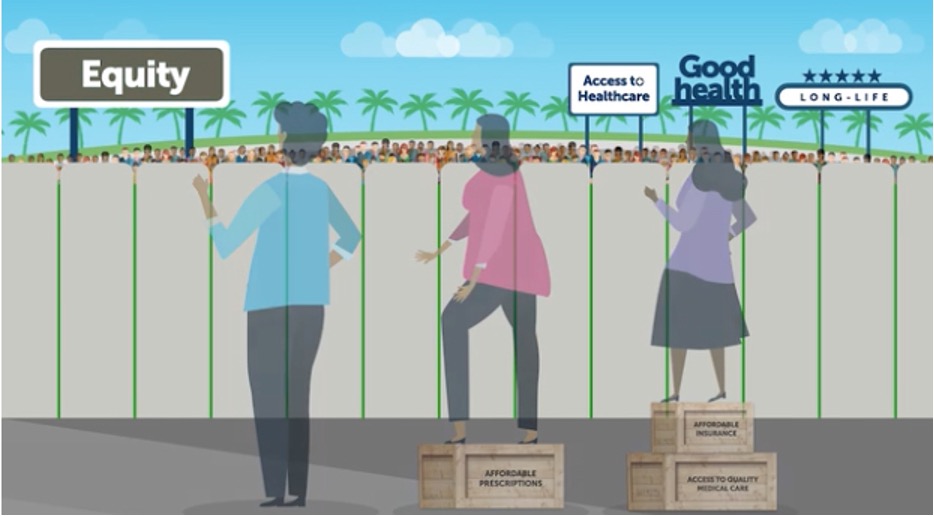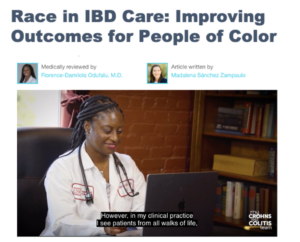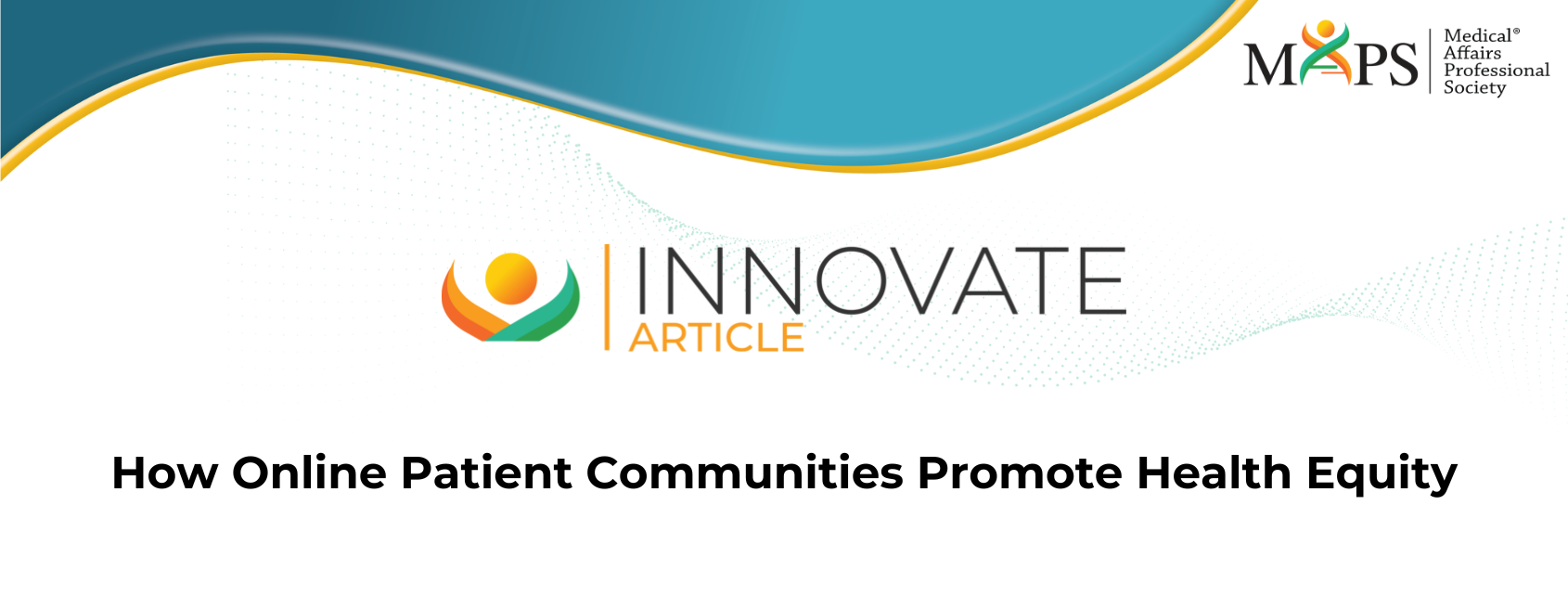According to a study in the journal Digestive Diseases and Sciences, black patients who present with symptoms of Inflammatory Bowel Disease are 91% less likely than white patients to receive the appropriate diagnostic evaluation. Harvard Health points out this delayed diagnosis means black patients are living longer with untreated inflammation, which can increase risk for abscesses and cancer. This is a stark example of health inequity – the failure of health systems to treat people of different backgrounds with the most appropriate care. Here, MAPS speaks with Eric Peacock, co-founder and CEO of MyHealthTeam, about how online patient communities can help Medical Affairs teams promote health equity.
MAPS: Eric, one idea you brought up when we were designing this interview is the difference between equity and equality. Can you explain this difference?
Eric: Equality means everyone is treated equally. Equity means each person has what they need to be as healthy as possible. Imagine three people of different height trying to look over a fence. The fence is equality: Each is treated the same. Equity is giving the shortest people boxes to stand on that let them see as well as those naturally taller. Our job in healthcare is to design the best boxes and figure out who needs them in order to best “see” over the fence to the best health outcomes.

Eric Peacock, co-Founder & CEO, MyHealthTeam

MAPS: Because Medical Affairs hears from patients and providers, it seems like we have the opportunity to notice which “boxes” people of varying populations need to achieve health equity. Are we doing all we can do?
Eric: What we’re seeing in literally every request for a proposal we get, is that Medical Affairs teams list “promotes health equity” as one of their desired goals. They know it’s important and are asking for it. But when you look at dedicated budget towards it, we’re only seeing a few Medical Affairs groups with dedicated health equity budgets. There are leaders in this space who choose to address health equity head-on, but many companies are still struggling to line up the business case behind it.
MAPS: So…is there a business case for health equity?
Eric: Absolutely. As a pharma company, you want to expand the pie of potential patients that can be on the therapy you create. One struggle is in diseases that are really hard to diagnose, like IBD or spondylitis or psoriasis. All of these conditions struggle with issues of health equity; for example, psoriasis is under-diagnosed in people with darker skin. Health equity means helping people in minority populations get appropriate diagnosis, leading to appropriate treatment. Second, even once you’re diagnosed, what’s the acceptable burden of disease given the state of the art? So many people get diagnosed with Crohn’s or migraines or MS and they start living with breakthrough symptoms or drug side effects they assume are their new normal. But the rate of change in medicine is so fast that new therapies can help these people newly diagnosed or diagnosed long ago live better lives. Take psoriasis, 15 years ago there were really only topicals to treat symptoms; now a number of biologic therapies can offer almost 100% clear skin. There are people who have lived the last 10 years thinking that “making psoriasis a little less awful” was acceptable. That’s why health equity is important – both patients and pharma want as broad a base of patients as possible to get diagnosed and get the best treatment. Also, and this is a no-brainer, the FDA is increasing requirements for diversity in clinical trials. To get regulatory approval, companies are going to need clinical trial diversity. How do you get that? By increasing health equity at every step in the process, from bringing on doctors running trials that look like the people you’re reaching out to, to more inclusive education and outreach.
MAPS: One hurdle for pharma in general and Medical Affairs specifically is the question of value of new treatments. Does the business case for health equity apply to the payer side as well?
Eric: Sure. Take lupus, for example. If left untreated, really bad things can happen like lupus nephritis where you end up on dialysis. These bad outcomes happen a lot more if you’re black. And it’s known that it takes a lot longer to get diagnosed if you’re black – you go a lot longer with this disease damaging your system. Imagine the cost difference of early diagnosis versus taking care of someone on dialysis. From a Health Economics perspective, all the incentive is to be preventive instead of reactive. We see a version of this now in the general population: routine screening went way down over covid and now there’s a huge uptick in diagnoses of later-stage cancer. Well, this underscreening and late diagnosis has been going on for years in underserved populations. Anyone studying this field for a while is going, “See!” If you think about paying the bill for healthcare, preventative education in underserved populations is a no-brainer.
MAPS: If the business case for health equity is a no-brainer, why don’t we see wider adoption?
Eric: One thing is language – we talked about equity versus equality and the term “health equity” is another example. Patients don’t talk about “health equity.” For patients, it’s “I’ve got these symptoms that aren’t being treated; I’m not getting diagnosed; I don’t know how to talk to my doctor so that I can get the treatment I need.” It’s the same on the pharma side. Some organizations don’t know what to do with language like “health equity” and “patient centricity.” But as soon as you start using language like clinical trial diversity and broadening the patient base, you find a lot more buy-in. Ironically, communicating the value of what we’re doing to patients or to industry hits some of the same challenges. Ultimately, it’s about asking what problem you’re solving for the user.
MAPS: So, what do we do about it – how can patient communities increase health equity?
Eric: Let’s stick with the case of IBD. Again, you show up with all the symptoms and if you’re black, you have 91% less likelihood of being worked up for a diagnosis than if you’re white. We’ve got this community of IBD patients and we decided to take the bull by the horns and equip traditionally underserved patients with the tools they need to get proper diagnosis and treatment. Fortunately, we were able to partner with Janssen on this, who have been a real leader in health equity. So we created a series of videos and articles, led by two, noted black gastroenterologists that say, “Here’s what you do if this happens to you – if you have these symptoms, this is what you deserve to get, and if you’re not getting it, here are the questions to ask your doctor.” Patient communities can also help us identify the inequities in healthcare. One thing we found in having 44 social networks that are free to more than 3 million members is that when you divide data by race or socioeconomics, differences in time-to-diagnosis and treatment emerge. Then we say, now that we know the problem, here’s what to do about it.
 MAPS: And is empowering patients what to do about it?
MAPS: And is empowering patients what to do about it?
Eric: Always, the burden or onus goes back to the patient and we empower them with the information they need to be their best self-advocate. This is what you tell your healthcare provider about your symptoms, this is what you say, this is how to get your insurance to pay for it, here’s how you get the workup.
MAPS: Like a doctor discussion guide.
Eric: Yes, but not the old, printed doctor discussion guide that patients would fill out and bring to their appointment. Now it’s interactive, has videos and is tailored to each individual patient. Like, if you’re a woman with triple-negative breast cancer, here’s the set of questions you should be talking about. Along with videos and roleplays about how to bring up these topics with your doctor if you’re not asked.
MAPS: Many hospitals are increasing the use of patient navigators – it’s almost like you’re equipping patients to be better navigators, themselves.
Eric: Imagine you have a sister or brother who’s in healthcare. If you have a challenging condition, you might ask them for advice on getting the best care. You know they will tell you how to make the system work for you. Patient communities have the opportunity to be that trusted advisor – to be the brother or sister who knows something about these conditions and can point the way from symptoms to the best treatment.
MAPS: Seems like health equity is a win-win for patients and pharma. Or maybe even a win-win-win with patients, industry and society.
Eric: It’s great when social justice lines up with business priorities. We’re proud to be at the center of connecting patients of all backgrounds with the diagnoses and treatments they need.



